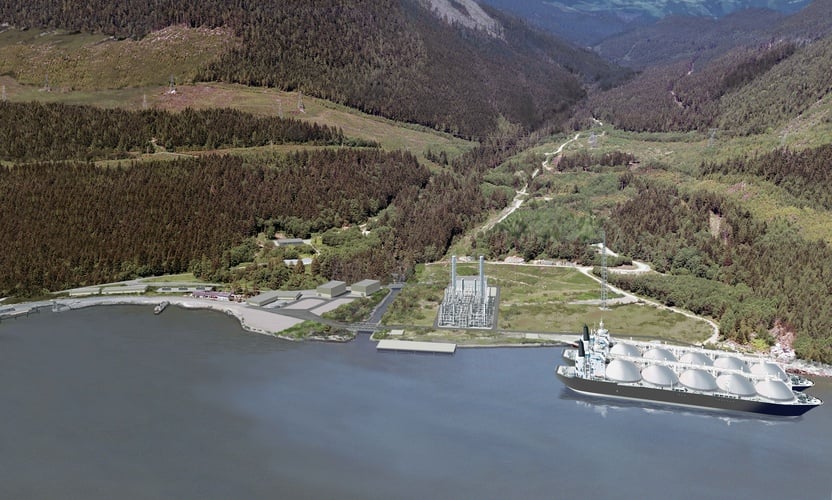Every day, methane promoters in British Columbia’s government manage to out-trump Donald Trump.
The hoopla over the $1.6-billion Woodfibre LNG terminal, which will industrialize Howe Sound and the city of Squamish, illustrates just how far the Christy Clark-led BC Liberal government will go to subvert the truth.
The government billed the event as maker of economic prosperity and the beginning of a winning fight against climate change.
Both claims read like Trump balderdash with no basis in reality.
In fact, every B.C. citizen should be alarmed by the Woodfibre LNG deal because it will fleece every taxpayer.
Let’s start with the subsidies and a little context.
Back in 2013 Premier Christy Clark promised that LNG would make the province rich, create a $100-billion savings fund, erase all debt and employ tens of thousands of people.
None of the hype materialized, nor will it for the long foreseeable future. Thanks to a global methane glut and a collapse in methane prices by 75 per cent, the LNG industry faces “an extremely challenging business environment.”
According to Forbes, Australia’s LNG industry is now bleeding billions of dollars of cash and earning nothing for the owners of the resource: Australians. It is also noteworthy that Asian markets have contracted four per cent despite the fall in LNG prices.
As a consequence, no company has made a final investment decision on 20 LNG proposals in B.C. — with the single exception of Woodfibre, a company owned by a Singapore tycoon, Sukanto Tanoto.
It is telling that one of Tanoto’s companies, Asian Agri, has been found guilty of tax evasion. (But that hasn’t caused Clark to rethink who she invites to do business in B.C.)
Taxpayers subsidize slim odds LNG gamble
Meanwhile, methane from British Columbia — due to the high-cost fracking of shales and their frontier remoteness, is among the world’s most expensive gas. Global markets now offer prices of $7 per million British Thermal Unit (Btu) but B.C. needs at least $10 per million Btu to make a dollar.
To save face on her outrageous LNG promises, Clark has now offered some significant giveaways to Tanoto that every British Columbian will pay for.
The first is a major electrical subsidy. Clark promised Woodfibre and any other LNG developer this month a reduced electrical rate or what’s known as an “eDrive rate.”
Two years ago, the government promised energy-intensive LNG projects electrical rates at $83.02 per megawatt hour.
Now Clark has offered LNG developers a stunning give-it-away “eDrive rate” of $53.60. That is less $30 below the original quote and about half the expected $100-plus cost of a megawatt-hour from the $9-billion Site C dam. That dam will raise electricity prices so Clark can give away money to tax evaders and LNG developers.
According to Eoin Finn, a former high-level consultant for KPMG, the electrical subsidy borders on larceny. “For Woodfibre’s power-hungry 140 Megawatt plant, the annual subsidy represented by the eDrive rate will total some $34 million per annum, or $860 million over its 25-year lifespan.”
But that’s not the only subsidy.
The government has halved the LNG tax rate to 3.5 per cent — among the lowest in the world and locked it in for 25 years. It granted Woodfibre and other LNG projects an 18-month holiday on carbon taxes. It accelerated capital cost write-offs. It lowered natural gas royalties to next to nothing and offers the industry nearly $200 million in drilling credits every year. And there will be no sales tax on methane purchases.
In addition, the province encouraged Woodfibre on Oct. 25 to pitch the District of Squamish a reduced property tax rate of $2 million instead of the normal mill rate of $8 million to $10 million.
Bearing great risk for puny reward
B.C.’s LNG advocates may argue that it took such incentives in order to jumpstart an industry that will produce revenue for the province and jobs for citizens.
But with so few jobs (just 100 permanent jobs for the Woodfibre plant) and no guarantee of revenue given all the subsidies, and a global LNG glut, the B.C. government has ignored the marketplace and embraced a Soviet model of LNG development.
In this special Clark model, taxpayers pay for everything: from the water given to shale gas frackers for free to the electricity provided to energy-gobbling terminals.
Even $100 million placed into a so-called LNG prosperity fund came out of taxpayers’ wallets via the Medical Services Plan.
Not even Trump has been that brazen in his outrageous business dealings.
Fraudulent claims that LNG fixes climate change
But there is more unreality.
Clark claimed that the Woodfibre approval “marks the beginning of a tremendous opportunity for British Columbia to play a significant role in the global fight against climate change, using the world’s cleanest LNG to help countries transition away from coal and oil.”
Incredibly, Clark has also claimed that LNG exports will help stop climate change from igniting and feeding wildfires across the west and burning up places like Fort McMurray.
But that’s a pipeline full of falseness.
Last spring, more than 90 scientists wrote a letter to the federal government, which the Trudeau government ignored. It outlined why LNG makes the climate more unstable, and it’s all due to methane leakage.
The scientists explained how the Petronas LNG terminal in particular “would be one of the single largest point source emitters in Canada” at five million tonnes a year and account for nearly 25 per cent of the province’s GHG emissions.
The scientists underscored a host of problems in provincial GHG accounting. Most specifically, the province has never told the truth about methane leakage from fracking, transport, turning the gas into liquid and converting it back into gas.
The B.C. government pretends that methane infrastructure only has a 0.28 percentage leakage rate, but that figure hasn’t been verified by field studies.
In contrast, the U.S. Environmental Protection Agency, an organization that President Elect Donald Trump has proposed to shutter, uses a methane leakage rate of 1.33 per cent. Other research has found some methane shale fields leak as much as nine per cent, which makes the product three times dirtier than coal.
In other words the government has underestimated leakage rates in order to pretend its LNG is “clean.” (There is, for the record, no such thing as clean energy: every form has an environmental cost.)
The scientists also noted that there is no guarantee that LNG from any terminal in B.C. will be used to replace coal-burning plants in Asia. Clark hasn’t signed that non-existent trade deal. (By one rough estimate Woodfibre will emit nearly 22 mega-tonnes of climate changing gases over a 25-year period.)
Secondly, methane just can’t serve as a climate saver or clean bridge fuel due to rising methane emissions from shale gas fracking and mining. Cornell researchers add that methane “is more than 100-times more powerful (than carbon dioxide) for the first decade after emission, 86-times over a 20-year period, and 34-times over 100 years.”
David Hughes, one of the nation’s foremost energy experts, calculates that B.C.’s LNG — if delivered to China — would be actually 27 per cent worse than coal over a 20-year timeframe.
He starkly concludes: “On a full-cycle emissions basis, the planet would be better off if China built state-of-the-art coal plants rather than burning B.C. LNG for at least the next 50 years.” It is true that at the burner tip, gas produces about half the carbon dioxide of coal.
More wounds to BC’s land and water
In addition to failing to truly account for methane leakage, the government of B.C. has never assessed the cumulative impacts of LNG on land disturbance, water consumption, groundwater contamination or earthquake hazards, which fracking has greatly aggravated in the province.
But that doesn’t seem to worry the government at all.
Years ago the great conservationist Roderick Haig-Brown lamented the province’s adolescent politics and its abusive obsession with resource booms. He called B.C. a “profligate province.”
The province’s ruinous resource booms left behind crackerbox towns, derelict forests, ravaged acres and scars upon the hillsides.
In the process, lamented Haig-Brown, the province became “a playground for economic imperialists with the spoils going unfailingly to the strong.”
And that’s exactly what Clark has done with her Trump-like promotion of LNG.
She has decimated the truth while making grandiose promises impossible to deliver. She has given away the farm to tax evaders with a Trump-like flourish. ![]()
Read more: Energy, BC Election 2017, BC Politics
















Tyee Commenting Guidelines
Comments that violate guidelines risk being deleted, and violations may result in a temporary or permanent user ban. Maintain the spirit of good conversation to stay in the discussion.
*Please note The Tyee is not a forum for spreading misinformation about COVID-19, denying its existence or minimizing its risk to public health.
Do:
Do not: